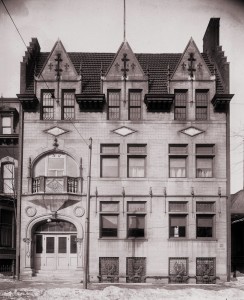Detroit Wheelmen: Fundraising to build a Clubhouse
Thursday, December 27th, 2012
Detroit Wheelmen Clubhouse at 53 E. Adams
The Detroit Bicycle Club was the city’s first in 1879. These were the day’s of highwheeler bicycles that appealed to young adventurous men but few others.
In fact L.J. Bates, the club’s first president wrote in that tricycles would eventually become more popular since they attracted a wider audience. A Free Press editorial from 1883 made the same prediction with this verbose attack on highwheelers.
Its demands upon the skill in balancing are too great to tempt many persons; those who indulge in it present a grotesque appearance in a garb which makes them look like convicts escaped from the penitentiary and which few care to display for the benefit or amusement of their fellowmen; while the dangers, or the necessity of guarding against danger, deprive the rider of much pleasure from scenery and wayside objects of interest.
However, tricycles never took over the market and interest in highwheelers faded. Detroit’s bicycle clubs faded as well.
The Comeback
But everything changed when the safety bicycle was introduced, a design not unlike today’s bicycles.
The safety bicycle not only kicked off Detroit’s golden age of bicycling, it helped revitalize the bicycle club scene. In 1890, the older clubs reorganized as the Detroit Wheelmen. In 1891, Detroit hosted the national convention for the League of American Wheelmen.
And with more women riding and the Detroit Wheelmen being for men only, the women-only Unique Cycling Club was formed 1893.
How close were the Detroit Wheelmen and Unique Cycling Club? In 1893 J. H. Gould was president of the former, while Mrs. J. H. Gould was president of the latter. Both clubs shared clubhouses, too.
The Clubhouse
Speaking of clubhouses, the growing interest in Detroit cycling meant a larger one was required. In order to build it they needed to raise funds — and they came up with a interesting idea. Since the circuses at the time didn’t tour during the winter, they could bring them to Detroit for a huge indoor show from Christmas to New Years.
According to the Free Press, “the Detroit Wheelmen have banished all thought of their favorite steeds for the time being… and [their] one-ring amateur circus grew into ‘the greatest show on earth,’ with three rings, clowns at all angles of the enclosure and elephants, trained lions and other wild beasts until you can’t rest.”
The circus was a “unqualified success” for the Detroit Wheelmen, raising over $2,000 in 1894 and $1,700 in 1895. It seemed they held their final circus in 1896 after they had begun construction on their new clubhouse.
The Unique Cycling Club played a role as well. They were in charge of the candy, popcorn, and flower booths. It appears they also oversaw the games of chance.
The Free Press published an article on December 26th, 1896 that describes this history and the Detroit cycling culture:
What a change has come over the Detroit Wheelmen in six short years! The old Detroit club disappeared from view, the Star club followed and for two or three years there was no bicycling organization in the city. Then several leaders organized the Detroit Wheelmen and for a long period the members met in modest quarters on Miami Avenue [later renamed Broadway.] The safety came into the field and proved such a success that the membership swelled and the club was warranted in securing splendid quarters on Washington avenue. Three years there showed an increase which necessitated more room and the old Strassburg Academy on Randolph street near Madison avenue was leased. Since moving there the organization has grown right along, until now there is paying membership and the future promises nothing but success for the organization. For a year the spirits who guide the destiny of the Wheelmen have thought of a club house of their own and after much hard work an arrangement was made whereby the club came into possession of a desirable piece of property on Adams avenue near Witherell street. On this site will be erected a $25,000 club house, work to commence next month if the weather is at all mild and by next summer the Detroit Wheelmen will own and occupy the most modern club house of any cycling organization in the west.
As it turned out, they spent $40,000 on the club house. That’s $1.1 million in 2012 dollars.
One interesting piece of trivia: They broke ground on the clubhouse on the same day Charles Brady King drove the first car in Detroit.
Shrine Circus
There’s one more interesting piece of this story.
Having seen the success of the Wheelmen’s circus, the Detroit Shriners decided to also raise funds with an indoor circus. They relied on Dr. Russell Pearce who organized the Detroit Wheelmen’s circuses. In 1906, they held the first ever Shrine Circus in Detroit which has grown across the U.S. since then.



